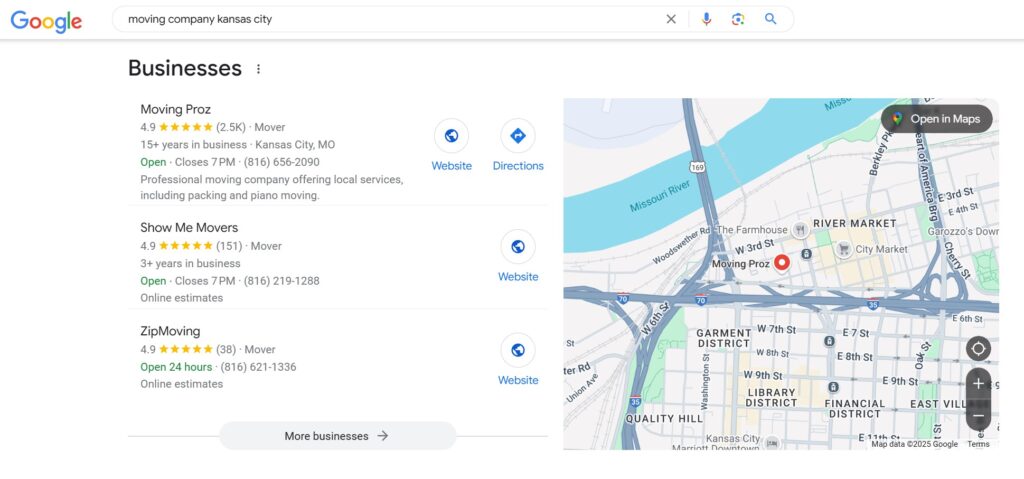15.3 million American households move each year—but without strong local SEO, your moving company is missing its share of this steady demand. In today’s market, customers don’t browse phonebooks; they search “movers near me” in Google and choose from the top local results. If you’re not appearing there, you’re losing out on business.
This guide provides practical strategies to help your moving company connect with customers when they’re actively searching. You’ll learn how to:
- Optimize your Google Business Profile to highlight your services and customer reviews
- Improve your website’s visibility for local moving-related searches
- Build trust through authentic reviews
- Increase your leads and bookings
These local SEO strategies focus on making your moving company more discoverable to the right customers. Let’s ensure your moving business appears when and where it matters most.
What Local SEO Means for Moving Companies
Local SEO is how your moving company gets found online by people in your area who need your services. It’s not about competing with every mover on the internet—just the ones in your town or city. By focusing on local search, you can make sure your business shows up when someone types “moving companies near me” into Google.
At its core, local SEO is about three things: making your business visible, credible, and accessible. This starts with creating and maintaining a Google Business Profile (GBP)—the free listing that puts your company on Google Maps and local search results.
Next, it’s about managing customer reviews. Positive reviews don’t just build trust; they also play a role in improving your ranking.
Finally, your website needs some attention, too. A fast, mobile-friendly site with optimized content and local keywords will help Google connect the dots between your business and potential customers.
Done right, local SEO doesn’t just bring more eyes to your company; it brings more people through the door—or at least to your contact form.
Setting Up and Managing Your Google Business Profile for Moving Companies

Your Google Business Profile (GBP) is one of the most important tools for putting your moving company on the local map—literally. Setting it up is pretty straightforward, but how you handle the details can make all the difference in how well it performs.
Start by entering your real business name—exactly as it appears on your signs, invoices, and other branding. Avoid the temptation to keyword-stuff here. “Smith Movers LLC” is great if that’s your actual name, but “Smith Movers – Best Local Moving Company in [Your City]” will land you in hot water with Google.
Next, fill out your address, phone number, and website URL. If you don’t list an address, your profile’s reach will be severely limited, so always include it if you can.
When it comes to choosing a category, select “Mover” as your primary one. For secondary categories, pick options that fit your services. “Moving and Storage Service”, “Pet Moving Service”, or “Piano Moving Service” might apply if you offer these. The right categories help Google understand what your business does and match you with the right audience.
Your profile is more than just text—it’s a chance to show off your company visually. Upload high-quality photos of your trucks, team, and equipment. Action shots of your movers doing their thing can help humanize your business. Videos are also a powerful way to stand out; a quick clip of your crew expertly packing a truck or a satisfied customer waving goodbye at their new home can go a long way.
Reviews are the backbone of a strong GBP. They build trust with potential customers and influence your search rankings. Encourage happy clients to leave a review by making the process simple—send them a direct link after the job is done or mention it during follow-up communication. The more authentic reviews you have, the better your profile will perform.
Don’t forget to update your GBP regularly. If your hours change, your contact information gets updated, or you add a new service, make sure your profile reflects it. Google loves active profiles, and so do potential customers.
Managing your profile doesn’t stop at setup. Regularly respond to reviews, both good and bad. Thank customers for their feedback, and if someone leaves a negative review, address their concerns professionally. This shows others that you care about your customers and are willing to resolve issues.
Lastly, take advantage of GBP posts. These allow you to share updates, promotions, or helpful moving tips directly on your profile. Think of it as a mini blog that keeps your audience engaged while signaling to Google that you’re active and relevant.
When optimized and managed properly, your Google Business Profile becomes a powerful tool for connecting with customers and growing your moving company. It’s the digital front door that helps people find, trust, and choose your business.
Why Positive Reviews Matter for Your Google Business Profile
Positive reviews are a big indicator of your Google Business Profile’s performance because they act as social proof, showing potential customers that your moving company is trustworthy and reliable. They also play a role in improving your profile’s visibility and rankings on Google. Make it a habit to respond to all reviews—thank customers for positive feedback and address negative reviews with professionalism and a willingness to resolve issues. Encourage clients to leave reviews by asking them directly, providing a reminder with their receipt, or sending them a quick link to make the process effortless.
Keyword Research for Moving Companies
To get your moving company to show up in search results, it all starts with good local keyword research. Begin by choosing a keyword research tool that fits your budget. If you’re just starting out and don’t need all the bells and whistles, more affordable tools like Keysearch or Keyword Chef will do the trick. These tools offer enough functionality to get solid results without breaking the bank. On the other hand, if you’ve got the budget for it and need more robust features, tools like Ahrefs or SEMRush can provide deeper insights—though they come at a much higher price.
Start your research with simple, “seed” keywords such as “moving company + location.” For example, “moving company St. Louis” or “movers in Kansas City.” These are usually the terms your location pages will target because they tend to have the highest search volume in your area. Once you’ve identified these primary keywords, dig into secondary keywords related to specific services or other areas you cover. Be sure to incorporate these secondary keywords naturally throughout your website content to give Google a complete picture of what your moving company offers. The goal is to optimize for both high-volume terms and more specific searches to capture a wide range of potential customers.
Structuring Your Website for Local SEO Success
When building a local SEO-friendly website for your moving company, it all begins with choosing a clear primary keyword to target. For example, if you’re based in Kansas City, “moving company Kansas City” would be the primary keyword for your homepage. This is where you’ll build your main SEO strategy around, ensuring that your homepage speaks directly to that keyword and serves as the cornerstone for your website’s content.
From there, the strategy expands to location pages targeting the cities and areas around your business. Each of these location pages should focus on a specific service area, like “moving services in Overland Park” or “movers in Lee’s Summit,” with unique content for each location.
While there’s flexibility in how you structure these pages, one golden rule is to avoid targeting the same keyword on multiple pages. If you target “moving company Kansas City” on both your homepage and a separate location page, they’ll end up competing with each other. This can have a negative impact on your search rankings, as Google won’t know which page to prioritize. Instead, focus on distinct keywords for each page, and allow each page to serve its own purpose within the broader structure of your site.
Mastering On-Page SEO for Your Local Moving Company Website
Local on-page SEO is all about optimizing the content on your website so it ranks well in search engines. After selecting your target keyword—like “moving company Kansas City”—the next step is to naturally incorporate synonyms and related terms throughout the page. This helps Google understand the topic of your page in greater detail. The primary keyword should be placed in key spots: the title tag, meta description, H2 heading, and naturally throughout your content to avoid keyword stuffing.
But it doesn’t stop there. A technique called entity optimization is key to ranking well for local SEO. Entities are terms that are related to your primary keyword but aren’t necessarily traditional keywords. For instance, if you’re targeting “moving company Kansas City,” Google will often associate the term with related words like “house,” “apartment,” or “truck.” These aren’t keywords, but they help Google understand the context of your content.
To ensure you’re covering all the bases, local SEO professionals often use on-page SEO tools like SurferSEO or Frase.io. These tools identify related entities that are ranking alongside your target keywords, allowing you to seamlessly incorporate them into your content. Even if you’re an expert in the moving industry, these tools help you fine-tune your page by suggesting terms and entities that you might have missed. This level of detail can elevate your on-page SEO, making sure your moving company website is as relevant and optimized as possible.
Building Citations and Backlinks for Your Moving Company Website
Building local citations and backlinks is an important part of strengthening your moving company’s SEO. Citations are simply mentions of your business on other websites, especially in local business directories like Yelp or Yellow Pages. While citations don’t carry the same weight they once did, they still offer value. Search engines see them as a signal that your business is legitimate and actively engaged in the local community. You can build these citations manually, or use tools like BrightLocal to streamline the process.
Backlinks, on the other hand, play a much more significant role in improving your website’s rankings. When other reputable websites link to your site, search engines view it as a vote of confidence, signaling that your content is trustworthy and authoritative. While acquiring high-quality backlinks for local SEO can be challenging, they’re worth the effort. To build backlinks, consider targeting local newspapers or publications in your industry, such as real estate sites or moving-related blogs. Effective strategies for gaining backlinks include guest posting, creating linkable assets like statistics pages about the moving industry, and leveraging digital PR campaigns. These types of assets naturally attract links and help improve your website’s authority, making it more likely to rank well in search results.
Why Mobile Optimization Matters for Your Moving Company Website
In today’s digital landscape, having a mobile-friendly website is essential for your moving company. With the majority of visitors browsing your site from mobile devices, a website that’s optimized for mobile ensures a smooth user experience. If your site isn’t mobile-friendly, you risk losing potential customers due to slow loading times or difficult navigation. Google also prioritizes mobile-friendly sites in search rankings, so optimizing your website for mobile is crucial for both user experience and SEO.
Building a Sustainable Local SEO Strategy for Your Moving Company
To achieve long-term success with local SEO, moving companies need to consistently implement key strategies: optimize your website structure, maintain an active Google Business Profile, gather positive reviews, and build high-quality citations and backlinks. These efforts, combined with ongoing keyword research and content optimization, will help improve your rankings and increase visibility in your target market.
At Galactic Turtle, we help movers with local SEO services for moving companies by implementing effective local SEO strategies to attract more leads.
Contact us and see how we can help you boost your online presence and drive more customers to your door.


